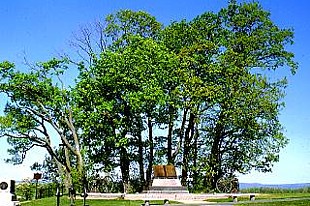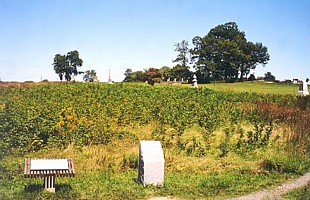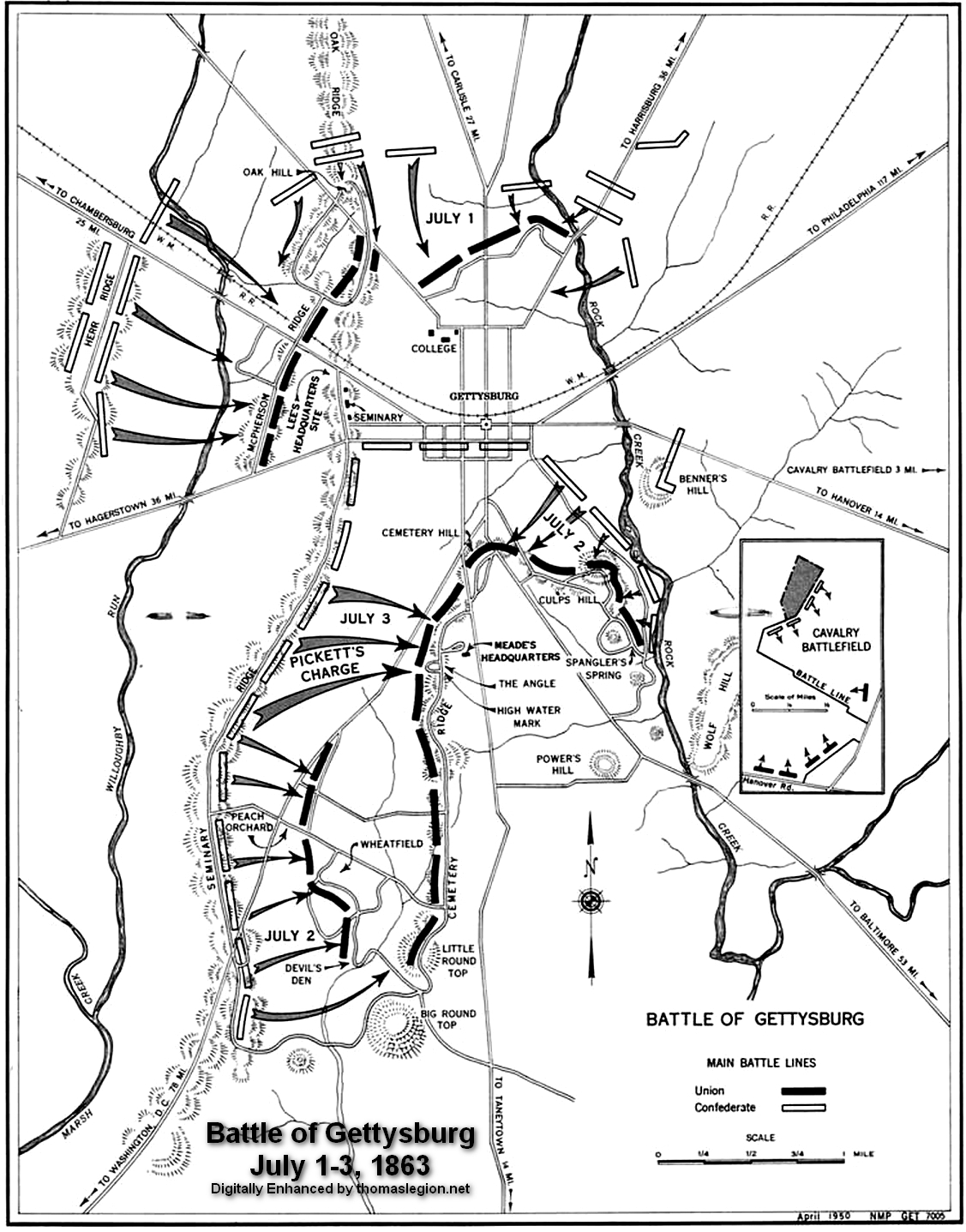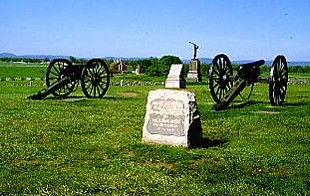|
The High Water Mark
High Water Mark of Gettysburg
| The High Water Mark |

|
| The High Water Mark, aka The Angle |
The High Water Mark
The High Water Mark of the Confederacy refers to an area on Cemetery Ridge
near Gettysburg, marking the farthest point reached by Confederate forces during Pickett's Charge on July 3, 1863. Similar
to the maritime high water mark, the term is a reference to arguably the Confederate Army's best chance of achieving victory
in the war and occurred on the third and final day of fighting at Gettysburg. The last day of fighting at the battle
of Gettysburg consisted of Culp's Hill, Cemetery Ridge, and two cavalry battles: one approximately three miles to
the east, known as East Cavalry Field, and the other southwest of Big Round Top mountain on South Cavalry Field.
This small grove or "copse" of trees had little or no significance prior
to the Battle of Gettysburg, but on July 3, 1863, it was the focal point around which swept vicious hand-to-hand
combat during the climax of "Pickett's Charge". The trees grow within a confined area known as "The Angle", named for the stone fence that bends to the west and then southward to border
the small pasture where the original trees stood. It was behind this stonewall that Union troops were positioned during the
battle. The title of "High Water Mark of the Rebellion" was bestowed upon the copse by John B. Bachelder, the first government
historian of the Gettysburg battlefield, who realized its significance during a visit to the site with a veteran of General Pickett's Division. It was through Bachelder's influence that the "High Water Mark of the
Rebellion Monument" was placed here and dedicated in 1892. The monument lists the commands of both armies that participated
in Pickett's Charge. This grouping of trees marked a Confederate crest of the battle and the war. After Gettysburg, Lee's Army of Northern Virginia would never reach such a high point again.
| High Water Mark and The Angle |

|
| The High Water Mark of Gettysburg |
(Right) Photo of view toward the High Water Mark and the Angle, marked by the single tree at left center,
from the southwest. General Kemper's brigade was in this area and approached the Union line from this direction. Gettysburg
NMP.
Approximately 7,000 Union soldiers of the Second Corps were positioned in
the area of the Angle and adjacent to it, commanded on July 3rd by Brigadier General John Gibbon. Some expressed relief to be over the ordeal of the artillery bombardment
as they gazed at the parade of southern infantry headed toward them. "Beautiful, gloriously beautiful did this vast array
appear in the lovely little valley," observed one soldier. The southerners reached the Emmitsburg Road and began to leap over
the stout fences. "The column pressed on," General Gibbon observed, "coming within musketry range without receiving immediately
our fire, our men envincing a striking disposition to withhold it until it could be delivered with deadly effect."
The Union line suddenly came to life, pouring a dreadful fire of lead into
the southern ranks. Within the acre of ground surrounding the clump of trees was the famed "Philadelphia Brigade", regiments
raised in and around the city of Philadelphia, under the command of Brig. General Alexander Webb. Webb's men sent volley after
volley into the mass of Confederates who pushed onward and, despite the intense fire, reached the stone wall. Congregating
along the wall, Pickett's men intermingled with some from Pettigrew's command and all traded rifle shots across the bare space
of 50 yards between them and some of Webb's men standing on the crest of the ridge. The last of Pickett's brigadiers, General Armistead, pushed his way through the crowd and led a charge over the wall. The fighting was brutal and at one point was hand to hand
in the copse of trees. The last remaining Union batteries used double-shots of canister to blast away groups of southerners
who ventured their way around the Yankees still holding the wall south of the trees. Without reinforcements or support, the
Confederates could not hold the Angle and clump of trees. Those who could retreated to Seminary Ridge leaving behind their dead and wounded.
| Battle of Gettysburg Map |

|
| The High Water Mark and Battle of Gettysburg. NPS. |
| Cushing in the Angle |

|
| Marker to Lt. Alonzo Cushing in the Angle |
(Right) This stone marker to Lt. Cushing was placed in the Angle by his
family, former officers and friends in 1887.
The High Water area is one of the most visited sites on the battlefield and
has been the scene of countless reunions and ceremonies. Veterans of the Philadelphia Brigade and Pickett's Division returned
to this site several times, grasping hands over the same stone wall that
so many had died over during the battle (Last Great Gettysburg Reunion of 1938). The reminders of the men who fought here and those that died live on in the granite and bronze monuments that stands within
the Angle.
While Pickett's men fought for possession of the Angle, the left wing of the
Confederate attacking force was facing a storm of their own from Union troops behind a stone wall stretching from the Angle
to Ziegler's Grove.
The Death of Lt. Cushing
| Lt. Cushing |

|
| (WI Hist. Society) |
Positioned just north of the copse of trees, Battery A, 4th US Artillery was commanded by 22 year-old Lt.
Alonzo Cushing. Born in Wisconsin in 1841, his family had moved to New York where the young Cushing grew up and attended West
Point, graduating in the class of 1861. He had served in staff positions and in command of Battery A in battles prior to Gettysburg,
but it is doubtful he had ever been involved in such intense fighting as he experienced here. Cushing's battery appeared to
be the focus of the Confederate artillery during the cannonade and was nearly destroyed in the furious bombardment. When the
Confederate cannon fire died away, Cushing found himself with only a handful of gunners and two working cannon. Though painfully
wounded by shell fragments, the young lieutenant was unwilling to personally leave the field or retire his shattered battery.
He gained permission from General Webb to move his two guns down to the wall in the Angle where he ordered that extra canister
rounds be piled by each gun. Cushing and his few artillerymen served these guns until the last, the lieutenant himself aiming
and firing one of the double-shotted pieces into the mass of Pickett's Virginians as they closed in on the stone wall. "I
will give them one more shot!", Cushing cried above the din. Seconds later a bullet struck him through the mouth, killing
him instantly, his lifeless body tumbling over the gun trail. The young lieutenant died a hero's death and was later buried
with full honors at his old alma mater, West Point.
Pickett's Brigadiers
| Gen. Armistead |

|
| (Generals in Gray) |
| Gen. Kemper |

|
| (Generals in Gray) |
On the other side of Cushing's marker is a scroll-top granite monument to
General Lewis Armistead, which marks the general location where he was mortally wounded among Cushing's guns on July 3. Erected
and dedicated by friends of the Armistead family in December 1887, it is the first monument dedicated to a Confederate officer
placed at Gettysburg and caused some minor controversy at the time of its placement in the Angle. Prior to the war, Armistead
had been close friends with General Hancock, but the division of the nation caused one to choose the southern cause while
the other remained loyal to the Union. At Gettysburg, the two almost met again. The wounded Armistead told his Union captors
to give his regards to Hancock, also desperately wounded while repulsing the charge. Though his wounds appeared to be non-fatal,
the general died in a Union field hospital on July 5. His body was recovered by friends, who had his remains transported to
Baltimore for burial in the yard of St. Paul's Church.
Of Pickett's three brigadiers, only James Kemper survived the charge. Ignoring orders not to go into the charge on horseback, Kemper rode into the charge
and led his brigade across the Emmitsburg Road south of the Codori Farm buildings. Kemper made his way to a point near the
Union defenses where he was shot by a Union soldier, "so close... that I could clearly recognize his features...". The desperately
wounded general lay on the field until spied by several Union soldiers who ran to him, placed him on a blanket, and began
to carry him into the Union lines. A small group of Confederates raced to Kemper's aid, retrieved him from his Union captors
and carried him to Seminary Ridge where he encountered General Lee. Though his wound appeared to be a mortal one, General
Kemper was taken back to Virginia and eventually recovered. After the war he would serve as the 37th Governor of Virginia
before his death in 1895.
Sources: Gettysburg National Military Park; National Park Service; Library of Congress; Official Records
of the Union and Confederate Armies.
Recommended Reading: Last Chance For Victory: Robert E. Lee And The Gettysburg
Campaign. Description: Long after nearly
fifty thousand soldiers shed their blood there, serious misunderstandings persist about Robert E. Lee's generalship at Gettysburg. What were Lee's choices before, during, and after the battle?
What did he know that caused him to act as he did? Last Chance for Victory addresses these issues by studying Lee's decisions
and the military intelligence he possessed when each was made. Continued below...
Packed with
new information and original research, Last Chance for Victory draws alarming conclusions to complex issues with precision
and clarity. Readers will never look at Robert E. Lee and Gettysburg the same way again.
Recommended Reading:
Pickett's Charge--The Last Attack at Gettysburg (Hardcover). Description: Pickett's Charge
is probably the best-known military engagement of the Civil War, widely regarded as the defining moment of the battle of Gettysburg and celebrated as the high-water mark of the Confederacy.
But as Earl Hess notes, the epic stature of Pickett's Charge has grown at the expense of reality, and the facts of the attack
have been obscured or distorted by the legend that surrounds them. With this book, Hess sweeps away the accumulated myths
about Pickett's Charge to provide the definitive history of the engagement. Continued below...
Drawing on
exhaustive research, especially in unpublished personal accounts, he creates a moving narrative of the attack from both Union and Confederate perspectives,
analyzing its planning, execution, aftermath, and legacy. He also examines the history of the units involved, their state
of readiness, how they maneuvered under fire, and what the men who marched in the ranks thought about their participation
in the assault. Ultimately, Hess explains, such an approach reveals Pickett's Charge both as a case study in how soldiers
deal with combat and as a dramatic example of heroism, failure, and fate on the battlefield.
Recommended Reading: The Artillery
of Gettysburg (Hardcover). Description: The battle of Gettysburg in July 1863, the apex of the Confederacy's final major invasion of the North,
was a devastating defeat that also marked the end of the South's offensive strategy against the North. From this battle until
the end of the war, the Confederate armies largely remained defensive. The Artillery of Gettysburg is a thought-provoking
look at the role of the artillery during the July 1-3, 1863 conflict. Continued below...
During the
Gettysburg
campaign, artillery had already gained the respect in both armies. Used defensively, it could break up attacking formations
and change the outcomes of battle. On the offense, it could soften up enemy positions prior to attack. And even if the results
were not immediately obvious, the psychological effects to strong artillery support could bolster the infantry and discourage
the enemy. Ultimately, infantry and artillery branches became codependent, for the artillery needed infantry support lest
it be decimated by enemy infantry or captured. The Confederate Army of Northern Virginia had modified its codependent command
system in February 1863. Prior to that, batteries were allocated to brigades, but now they were assigned to each infantry
division, thus decentralizing its command structure and making it more difficult for Gen. Robert E. Lee and his artillery
chief, Brig. Gen. William Pendleton, to control their deployment on the battlefield. The Union Army of the Potomac
had superior artillery capabilities in numerous ways. At Gettysburg,
the Federal artillery had 372 cannons and the Confederates 283. To make matters worse, the Confederate artillery frequently
was hindered by the quality of the fuses, which caused the shells to explode too early, too late, or not at all. When combined
with a command structure that gave Union Brig. Gen. Henry Hunt more direct control--than his Southern counterpart had over
his forces--the Federal army enjoyed a decided advantage in the countryside around Gettysburg. Bradley
M. Gottfried provides insight into how the two armies employed their artillery, how the different kinds of weapons functioned
in battle, and the strategies for using each of them. He shows how artillery affected the “ebb and flow” of battle
for both armies and thus provides a unique way of understanding the strategies of the Federal and Union
commanders.
Recommended
Reading:
Lost Triumph: Lee's Real Plan at Gettysburg--And Why It Failed.
Description: A fascinating narrative-and a bold new
thesis in the study of the Civil War-that suggests Robert E. Lee had a heretofore undiscovered strategy at Gettysburg that,
if successful, could have crushed the Union forces and changed the outcome of the war. The Battle of Gettysburg is the pivotal
moment when the Union forces repelled perhaps America's greatest commander-the
brilliant Robert E. Lee, who had already thrashed a long line of Federal opponents-just as he was poised at the back door
of Washington, D.C. It is
the moment in which the fortunes of Lee, Lincoln, the Confederacy, and the Union
hung precariously in the balance. Continued
below...
Conventional
wisdom has held to date, almost without exception, that on the third day of the battle, Lee made one profoundly wrong decision.
But how do we reconcile Lee the high-risk warrior with Lee the general who launched "Pickett's Charge," employing only a fifth
of his total forces, across an open field, up a hill, against the heart of the Union defenses? Most history books have reported
that Lee just had one very bad day. But there is much more to the story, which Tom Carhart addresses for the first time. With
meticulous detail and startling clarity, Carhart revisits the historic battles Lee taught at West Point and believed were
the essential lessons in the art of war-the victories of Napoleon at Austerlitz, Frederick the Great at Leuthen, and Hannibal
at Cannae-and reveals what they can tell us about Lee's real strategy. What Carhart finds will thrill all students of history:
Lee's plan for an electrifying rear assault by Jeb Stuart that, combined with the frontal assault, could have broken the Union
forces in half. Only in the final hours of the battle was the attack reversed through the daring of an unproven young general-George
Armstrong Custer. About the Author: Tom Carhart has been a lawyer and a historian for the Department of the Army in Washington, D.C. He is
a graduate of West Point, a decorated Vietnam veteran, and has earned a
Ph.D. in American and military history from Princeton University. He is the author of four books of military history and teaches at Mary Washington College
near his home in the Washington, D.C.
area.
Recommended Reading:
ONE CONTINUOUS FIGHT: The Retreat from Gettysburg and
the Pursuit of Lee's Army of Northern Virginia, July 4-14, 1863 (Hardcover) (June
2008). Description: The titanic three-day
battle of Gettysburg left 50,000 casualties in its wake, a
battered Southern army far from its base of supplies, and a rich historiographic legacy. Thousands of books and articles cover
nearly every aspect of the battle, but not a single volume focuses on the military aspects of the monumentally important movements
of the armies to and across the Potomac River. One Continuous Fight: The Retreat from Gettysburg and the Pursuit of Lee's Army of Northern Virginia, July
4-14, 1863 is the first detailed military history of Lee's retreat and the Union effort to catch and destroy the wounded Army
of Northern Virginia. Against steep odds and encumbered with thousands of casualties, Confederate commander Robert E. Lee's
post-battle task was to successfully withdraw his army across the Potomac River. Union commander George G. Meade's equally
difficult assignment was to intercept the effort and destroy his enemy. The responsibility for defending the exposed Southern
columns belonged to cavalry chieftain James Ewell Brown (JEB) Stuart. If Stuart fumbled his famous ride north to Gettysburg, his generalship during the retreat more than redeemed his
flagging reputation. The ten days of retreat triggered nearly two dozen skirmishes and major engagements, including fighting
at Granite Hill, Monterey Pass, Hagerstown, Williamsport, Funkstown,
Boonsboro, and Falling Waters. Continued
below...
President Abraham
Lincoln was thankful for the early July battlefield victory, but disappointed that General Meade was unable to surround and
crush the Confederates before they found safety on the far side of the Potomac. Exactly what Meade did to try to intercept the fleeing Confederates, and how the
Southerners managed to defend their army and ponderous 17-mile long wagon train of wounded until crossing into western Virginia on the early morning of July 14, is the subject of this study.
One Continuous Fight draws upon a massive array of documents, letters, diaries, newspaper accounts, and published primary
and secondary sources. These long-ignored foundational sources allow the authors, each widely known for their expertise in
Civil War cavalry operations, to describe carefully each engagement. The result is a rich and comprehensive study loaded with
incisive tactical commentary, new perspectives on the strategic role of the Southern and Northern cavalry, and fresh insights
on every engagement, large and small, fought during the retreat. The retreat from Gettysburg
was so punctuated with fighting that a soldier felt compelled to describe it as "One Continuous Fight." Until now, few students
fully realized the accuracy of that description. Complimented with 18 original maps, dozens of photos, and a complete driving
tour with GPS coordinates of the entire retreat, One Continuous Fight is an essential book for every student of the American
Civil War in general, and for the student of Gettysburg in
particular. About the Authors: Eric J. Wittenberg has written widely on Civil War cavalry operations. His books include Glory
Enough for All (2002), The Union Cavalry Comes of Age (2003), and The Battle of Monroe's Crossroads and the Civil War's Final
Campaign (2005). He lives in Columbus, Ohio.
J. David Petruzzi is the author of several magazine articles on Eastern Theater cavalry operations, conducts tours of cavalry
sites of the Gettysburg Campaign, and is the author of the popular "Buford's Boys." A long time student of the Gettysburg
Campaign, Michael Nugent is a retired US Army Armored Cavalry Officer and the descendant of a Civil War Cavalry soldier. He
has previously written for several military publications. Nugent lives in Wells, Maine.
Recommended Reading:
General Lee's Army: From Victory to Collapse. Review:
You cannot say that University of North
Carolina professor Glatthaar (Partners in Command) did not do his homework in this massive examination
of the Civil War–era lives of the men in Robert E. Lee's Army of Northern Virginia. Glatthaar spent nearly 20 years
examining and ordering primary source material to ferret out why Lee's men fought, how they lived during the war, how they
came close to winning, and why they lost. Glatthaar marshals convincing evidence to challenge the often-expressed notion that
the war in the South was a rich man's war and a poor man's fight and that support for slavery was concentrated among the Southern
upper class. Continued below...
Lee's army
included the rich, poor and middle-class, according to the author, who contends that there was broad support for the war in
all economic strata of Confederate society. He also challenges the myth that because Union forces outnumbered and materially
outmatched the Confederates, the rebel cause was lost, and articulates Lee and his army's acumen and achievements in the face
of this overwhelming opposition. This well-written work provides much food for thought for all Civil War buffs.
Recommended Reading: Retreat from Gettysburg:
Lee, Logistics, and the Pennsylvania Campaign (Civil War America) (Hardcover). Description: In a groundbreaking, comprehensive history of the Army of Northern Virginia's retreat
from Gettysburg in July 1863, Kent Masterson Brown draws on
previously unused materials to chronicle the massive effort of General Robert E. Lee and his command as they sought to expeditiously
move people, equipment, and scavenged supplies through hostile territory and plan the army's next moves. More than fifty-seven
miles of wagon and ambulance trains and tens of thousands of livestock accompanied the army back to Virginia. Continued
below...
The movement
of supplies and troops over the challenging terrain of mountain passes and in the adverse conditions of driving rain and muddy
quagmires is described in depth, as are General George G. Meade's attempts to attack the trains along the South Mountain range and at Hagerstown and Williamsport, Maryland. Lee's deliberate pace, skillful
use of terrain, and constant positioning of the army behind defenses so as to invite attack caused Union forces to delay their
own movements at critical times. Brown concludes that even though the battle of Gettysburg
was a defeat for the Army of Northern Virginia, Lee's successful retreat maintained the balance of power in the eastern theater
and left his army with enough forage, stores, and fresh meat to ensure its continued existence as an effective force.
|

